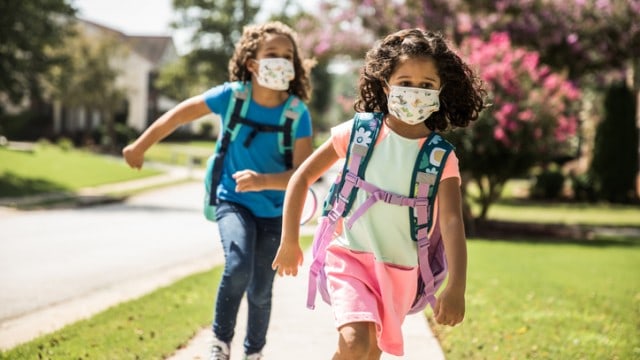Kids are heading back to school amid a national surge in COVID-19 cases.
Although the proportion of COVID-19 infections caused by the delta variant is approaching 100%, in-person learning, with the proper risk-mitigation efforts (masks, hand hygiene) in place, can still be safely achieved and should be the ultimate goal, said Northwestern University experts in pediatric infectious diseases and epidemiology.
The following experts answered questions ahead of the school year:
Dr. Larry Kociolek, a pediatric infectious diseases physician-scientist at Northwestern University Feinberg School of Medicine and the Ann & Robert H. Lurie Children’s Hospital of Chicago. As medical director of infection prevention and control, he leads the COVID-19 response at Lurie Children’s, and he is leading a multidisciplinary team of research investigators at Lurie Children’s, Northwestern and the University of Chicago who are studying COVID-19 in schools and the impact of COVID-19 on Chicago children and families.
Mercedes Carnethon, vice chair of the department of preventive medicine and a professor of preventive medicine (epidemiology) and medicine (pulmonary and critical care) at Feinberg. Her research focuses broadly on the epidemiology of cardiovascular disease, obesity, diabetes, lung health and cognitive aging in the population subgroups defined by race/ethnicity, geography, socioeconomic status, gender and sexual orientation/gender identity.
What are the current rates of COVID among children?
Dr. Larry Kociolek: “The delta variant was barely a blip in Chicago and many parts of the country even six weeks ago, but the game has changed now. In the last month, two things have happened: The rates of COVID-19 in all age groups, but particularly in children, have increased substantially, and the proportion of infections caused by the delta variant is approaching 100% in Chicago. Delta is much more transmissible, particularly in settings that have a high proportion of unvaccinated individuals in indoor settings. Hence our concern about schools with kids 12 and under and high schools with low student vaccination rates.”
Why has masking become so controversial?
Kociolek: “There’s a lot of discussion about unmasking, but there’s no convincing evidence that masks are generally harmful. While a very small minority of children may report some discomfort or other minor symptoms, we know that children in schools have adapted very well to wearing face coverings. And outside of vaccination, face covering seems to be the most effective way of not transmitting the infection. Decisions to remove masking in the midst of substantially increasing community transmission and prevalence of the delta variant is not a winning strategy if our goal is to keep kids in the classroom.”
Mercedes Carnethon: “Unfortunately, it seems those who are arguing not to wear masks are also suggesting not to vaccinate. There are safety precautions in everyday aspects of our life that we don’t fight against, so why we’re fighting against masking is beyond me. I would hope these parents also don’t refuse to put seatbelts on their kids, refuse to use car seats or refuse to wear a helmet while riding bikes. Masking is yet another safety precaution, it doesn’t cut off one’s ability to breathe.”
What happens when you don’t mask?
Kociolek: “Schools that have gone back in the South, such as in Mississippi, Georgia and Indiana, many have gone back without a mask mandate, and what’s being reported this week is schools in these states have already been forced to transition to remote learning or institute a mask mandate because of an increased activity of COVID-19 among students. That’s counterproductive to keeping kids in the classrooms. And it’s all because of ill-advised decisions to remove a mask mandate under these current conditions.”
Some say last year was a ‘lost year’ in education. Will that happen this year?
Kociolek: “Our research has confirmed that for schools that went back to in-person learning and had risk-mitigation strategies in place, those students benefited from in-person learning, socialization and resources, and it helped address and combat some of the mental health implications from lack of in-person learning. Illinois this past spring made the very important decision to promote in-person instruction with limited exception for this school year, which is great.”
Carnethon: “I think we as a nation have an opportunity to recover this year because we have the tools we need to protect children and teachers to safely attend school in person. Hybrid is not necessarily safer because what parents do with their kids on non-hybrid days could be potentially less safe (e.g. without masks, etc.). I don’t see any reason for this year to have to be as disruptive as last year.
“Seventy percent of U.S. adults have had at least one dose of the vaccine. The risks of severe illness and hospitalization are very low. I see this as great potential to get back on track and correct what has gone wrong in the previous year.”


